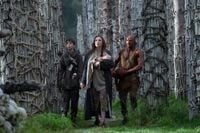Nearly two decades after the chilling 2007 sequel, the much-anticipated third installment of the iconic outbreak horror franchise, "28 Years Later," has finally arrived in theaters, reigniting interest in the saga that began with Danny Boyle and Alex Garland’s groundbreaking 2002 film "28 Days Later." This new chapter not only revisits the terrifying world ravaged by the Rage Virus but also boldly reshapes the narrative landscape, offering fans both familiar thrills and fresh, unsettling perspectives.
"28 Days Later" introduced audiences to a post-apocalyptic London, where the Rage Virus swiftly transforms victims into ferocious, fast-moving infected, a terrifying departure from the traditional lumbering zombies. The film’s success was powered by its innovative use of lightweight digital technology, allowing Boyle to capture haunting scenes of deserted city streets with guerrilla-style filmmaking that felt raw and immediate. Central to the story was Jim, played by Cillian Murphy, whose journey through chaos and survival helped define the franchise’s emotional core.
Following this, the 2007 sequel "28 Weeks Later," directed by Juan Carlos Fresnadillo and produced under Boyle’s executive guidance, shifted the focus to American NATO forces attempting to establish a safe zone in London. Starring Robert Carlyle, Rose Byrne, and Jeremy Renner, this installment chronicled the Harris family’s reunion and the devastating consequences that followed. The film culminated in a grim revelation: the Rage Virus had spread to mainland Europe, evidenced by a chilling scene of infected swarming the underground trains of Paris near the Eiffel Tower.
However, "28 Years Later," directed once again by Boyle and penned by Garland, makes a bold narrative choice by retconning this plot point early on. A title card at the film’s start explains that the French successfully pushed the virus back across the Channel, confining the outbreak to the British mainland. Boyle explained this creative decision as a desire to keep the story deeply rooted in Britain, saying, "What was unique about the first film and was the best choice we ever made about it was that it featured entirely British. It was just that land. And it was extraordinary thinking about something that powerful breaking out in that particular space, and it had to be dealt with by the inhabitants of that land. And we decided to concentrate on that." He further emphasized that while there is "nothing wrong with 28 Weeks Later," they chose "not to follow those story elements" and instead made a "bold choice" to declare the virus driven back from mainland Europe.
Set on Holy Island off England’s northeast coast, "28 Years Later" paints a haunting picture of a quarantined United Kingdom, isolated and locked down as the rest of the world has seemingly defeated the virus. The island community, self-governing and fiercely protective, lives off the land, cultivating food and brewing beer, while the mainland remains a lawless wasteland where infected roam freely. The island is connected to the mainland by a causeway accessible only at low tide, which the menfolk use to make dangerous foraging expeditions, hunting the infected with bows and arrows to hone their survival skills.
The film centers on Jamie (Aaron Taylor-Johnson) and his 12-year-old son Spike (Alfie Williams), who is being groomed as a hunter-gatherer. Spike’s mother, Isla (Jodie Comer), is gravely ill, and when Spike learns of a mysterious doctor rumored to be on the mainland who might help her, he defies his father’s orders and embarks on a perilous journey to find this enigmatic figure. Ralph Fiennes delivers a memorable performance as the slightly mad but deeply kind doctor, whose arrival injects a surreal, almost fever-dream quality into the film’s latter half.
Boyle and Garland’s storytelling here is more introspective and slower paced than previous entries, focusing on themes of humanity’s loss of compassion amid the apocalypse. The film explores a society where teaching children to kill has become a rite of passage, schools operate under military-like discipline, and survivors have devolved into tribal, cult-like groups. The cinematography, led by Anthony Dod Mantle, is striking, featuring haunting visuals such as towering piles of bones, vast starry skies, and eerie vapour trails, creating a stylized yet bleak atmosphere that complements the film’s tone.
Critics note that "28 Years Later" is more artful and philosophically ambitious, presenting a “messed up, modern day fairy tale quest” through Spike’s eyes as he navigates dangers and eccentric personalities in a fractured world. While the film’s tonal shifts—from bleakness to moments of sentimentality—can feel uneven, Alfie Williams’s performance as Spike anchors the narrative, delivering a compelling portrayal of innocence forced to confront brutality. Jodie Comer shines in her role despite occasional over-the-top moments, while Aaron Taylor-Johnson’s portrayal of Jamie is more one-dimensional, embodying a father clinging to control in a collapsing society.
Fans of the franchise have flocked to revisit the earlier films ahead of "28 Years Later," with streaming platforms making "28 Days Later" and "28 Weeks Later" widely accessible. The original film is available on Prime Video and BBC iPlayer in the UK, while "28 Weeks Later" can be streamed on Prime Video and Hulu in the US, and Prime Video in the UK. This renewed interest underscores the franchise’s enduring appeal and the anticipation surrounding Boyle and Garland’s return.
Early reviews for "28 Years Later" are overwhelmingly positive, boasting a 7.4/10 rating on IMDb and an impressive 95 percent on Rotten Tomatoes. Critics praise the film for deepening the franchise’s mythology while delivering intense tension, action, and emotional depth. One reviewer noted, "Not only is 28 Years Later well worth the wait, but the story benefits from the lengthy gap between installments. It delivers big with Rage Virus-sparked tension and action, but also takes an unexpected turn that's staggeringly refreshing and effective." Another hailed Boyle’s work, saying, "He has delivered a film that doesn’t just extend the franchise, but deepens it. 28 Years Later is thrilling, terrifying, heartbreaking, and, above all, human."
Despite its slower pace and tonal complexity, "28 Years Later" stands as a visually dazzling and narratively rich addition to the franchise. It balances horror and humanity, offering fans a fresh perspective on a world forever altered by the Rage Virus. As the film unfolds, it becomes clear that Boyle and Garland are not merely revisiting old ground but are pushing the boundaries of the genre, blending folk horror, social commentary, and apocalyptic survival into a unique cinematic experience.
"28 Years Later" opened in theaters worldwide on June 20, 2025, inviting both longtime fans and newcomers to immerse themselves in a haunting vision of a quarantined Britain, where survival demands not just strength but a reckoning with what it means to be human in the face of relentless darkness.





